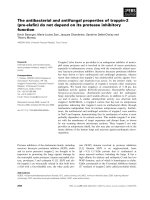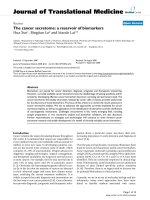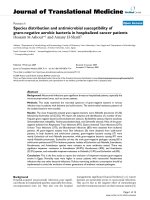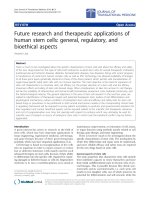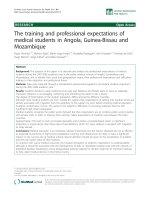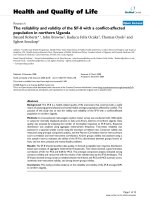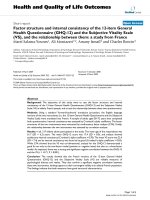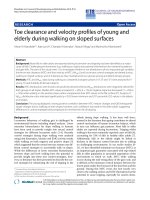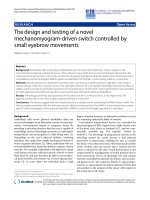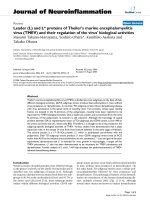Báo cáo hóa học: " The structural and optical properties of GaSb/InGaAs type-II quantum dots grown on InP (100) substrate" ppt
Bạn đang xem bản rút gọn của tài liệu. Xem và tải ngay bản đầy đủ của tài liệu tại đây (276.58 KB, 6 trang )
ORIGINAL PAPER Open Access
The structural and optical properties of
GaSb/InGaAs type-II quantum dots grown on
InP (100) substrate
Zhang Shuhui
1,2
, Wang Lu
2*
, Shi Zhenwu
2
, Cui Yanxiang
2
, Tian Haitao
2,3
, Gao Huaiju
2
, Jia Haiqiang
2
,
Wang Wenxin
2
, Chen Hong
2
and Zhao Liancheng
1*
Abstract
We have investigated the structural and optical properties of type-II GaSb/InGaAs quantum dots [QDs] grown on
InP (100) substrate by molecular beam epita xy. Rectangular-shaped GaSb QDs were well developed and no
nanodash-like structures which could be easily found in the InAs/InP QD system were formed. Low-temperature
photoluminescence spectra show there are two peaks centered at 0.75eV and 0.76ev. The low-energy peak
blueshifted with increasing excitation power is identified as the indirect transition from the InGaAs conduction
band to the GaSb hole level (type-II), and the high-energy peak is identified as the direct transition (type-I) of GaSb
QDs. This material system shows a promising application on quantum-dot infrared detectors and quantum-dot
field-effect transistor.
Introduction
Qua ntum-size nanostruc ture materials have always been
the research focus [1-5]. In recent years, staggered lineup
type-II quantum-size nanostructures are of great research
interest due to their possible application in many novel
devices [6,7]. Notably, a large research effort has been
focused on the type-II quantum-size nanostructures com-
posed of III and V direct-bandgap semiconductor materi-
als, such as GaSb/GaAs [8-10], InAlAs/InP [11], InP/
InGaP [12,13], InP/GaAs [14], GaAsSb/GaAs [15], and
InAs/GaSb [16,17]. The reason is that they offer compara-
tively large bandgap energies and provide a possibility of
covering the whole middle and far-infared optical range
for pho toelectric devices. Among these material syste ms,
GaSb/GaAs quantum dot [QD] is an outstanding repre-
sentative since its giant valence band offset, characteristic
to this system, may result in practical applications for
light-emitting devices in the spectral range of 1 to approxi-
mately 1.5 μm, such as in ophthalmology, neurology, and
endoscopy [18].
Here, we provided another type-II QD material system,
GaSb/InGaAs/InP, as another promising building block
for optoelectronic and microelectronic applications. Com-
pared to GaSb/GaAs type-II QDs, the bandgap of this sys-
tem can be adjusted by both the QD-relevant structural
characteristics and the In component in a InGaAs matrix.
InP substrate is employed instead of GaAs for two reasons:
one is that the lattice of InP is matc hed with the InGaAs
buffer layer which has higher electron mobility; the other
is that it may make the absorption peak position easily red
shifted to 1.3 to approximately 1.55 μm. All these features
show a promising application on the quantum-dot infrared
detectors [QDIP] and quantum-dot field-effect transistors
[QD-FET].
In this work, we investigated the structural and optical
properties of type-II GaSb/InGaAs QDs grown on InP
(100) substrate using molecular beam epitaxy [MBE].
Experiments
GaSb/InGaAs type-II QDs were grown on the (100) semi-
insulation Fe-doped InP substrate by a V80 MBE system
(VG Semicon, East Grinstead, Weat Sussex, UK). The
growth mode followed is the Stranski-Krastanow [SK]
mode. Firstly, the surface oxides of the InP substrate
were desorbed at a substrate temperature of approximately
* Correspondence: ;
1
School of Materials Science and Engineering, Harbin Institute of
Technology, Harbin, 150001, China
2
National Laboratory for Condensed Matter Physics, Institute of Physics,
Chinese Academy of Sciences, Beijing, 100190, China
Full list of author information is available at the end of the article
Shuhui et al. Nanoscale Research Letters 2012, 7:87
/>© 2012 Shuhui et al; l icensee Springer. This is an Open Access article distributed under the terms of the Creative Commons Attribution
License ( which permits unrestricted use, distribution, and reproduction in any medium,
provided the original work is properly cited.
500°C. A 500-nm In
0.53
Ga
0.47
As buffer layer matched with
the InP substrate was then deposited at a growth rate of
5,000Å/h. Four-monolayer [ML] GaSb QDs were depos -
itedwithaslowgrowthrateof0.12ML/s.Therewasa
3-min growth interruption before and after QD growth.
Afterwards, a 30-nm In
0.53
Ga
0.47
As capping layer was
grown at a rate of 5,000Å/h. A 50-nm In
0.52
Al
0.48
As bar-
rier layer was grown at a rate of 5,300Å/h. Finally, GaSb
QDs were grown for the surface morphology measure-
ments. The growth temperature used for the whole growth
process was approximately 480°C. In the growth process of
the sample, the InGaAs capping layer was doped with Si.
The morphology measurements of the QDs were char-
acterized by a atomic force microscopy [AFM] and a scan-
ning transmission electron microscope [STEM]. The AFM
measurements were conducted in a tapping mode in air,
and the STEM measurements were obtained using a Tec-
nai F20 super-twin machine (FEI Co., Hillsboro, OR,
USA). The photoluminescence [PL] measurements were
performed for the optical properties of the sample at 20 K
using the source of a 532-nm line, and the excitation
power is changed from 3 mW to 30 mW.
Results and discussion
In order to characterize th e density, shape, diameter, and
height size distribution of GaSb/InGaAs QDs on InP (100)
substrate, the AFM and STEM measurements were carried
out. Figure 1 shows the AFM and STEM images of GaSb/
In
0.53
Ga
0.47
As QDs a nd the histo gram of the heig ht of
GaSb/In
0.53
Ga
0.47
As QDs. As shown in Figure 1a, the
statistical data indicate that the density of the QDs is
approximately 7 × 10
9
cm
-2
andthattheshapeofGaSb
QDs is rectangular-shaped which is the same with GaSb/-
GaAs QDs [9]. Figure 1b shows the height distribution
of the GaSb/In
0.53
Ga
0.47
As QDs. From the figure, we
can see that the height of the quantum dots is mainly
concentrated to approximately 6 nm. Due to the well
known ‘tip eff ect’ of AFM, the results of AFM measure-
ments cannot describe the precise lateral size of the QDs.
The STEM measurements were used to image the config-
uration for overcoming this limitation of AFM measure-
ments. Figure 1c shows that the lateral size of the QDs is
approximately 40 nm. The results indicate that the rectan-
gular-shaped GaSb/InGaAs QDs are well developed in the
SK growth mode, but no nanodash-like struct ures which
are easily found in the InAs/InP QD system were formed
[19]. However, there seemed to be some smaller QDs (the
lateral size was about 20 nm) in the AFM image. By mea-
suring the height distribution of the QDs, we observed
that they were lower than 2 nm. We did not observe such
bimodal distribution in the STEM images. So, we thought
that these mound-like structures were possibly from t he
non-optimized InGaAs buffer layer. Another possible
explanation was that the formation of the InGaAsSb wet-
ting layer resulted in the accumulation of individual atoms
on the surface to form a mound-like structure, due to the
intermixing of As and Sb during the growth of GaSb QD.
Figure 2 shows the PL spectra of four-ML QDs at 20 K
with an excitation power of 3 mW. It is obvious that there
are two peaks centered at 0.75eV and 0.76eV, respectively.
For identifying these two peaks, low-temperature excita-
tion power-dependent PL spectrum tests were carried out,
and the results were shown in Figure 3a. Figure 3b shows
the PL peak energies wi th various excitation powers. It is
obvious that the low-energy peak blueshifts with the
increasing excitation power, while the position of the
high-energy peak is almost constant. The PL peak blue-
shifts with increasing excitation power is a special charac-
ter of type-II heterostructures. The other supporting
evidence of the type-II luminescence is the linear depen-
dence of the PL peak energies over the third root of the
excitation density [20]. The inset of Figure 3b shows the
345678910
0
5
10
15
20
25
30
35
Number
The height (nm)
(b)
Figure 1 AFM and STEM images of GaSb/In
0.53
Ga
0.47
As QDs and histogram of the height of GaSb/In
0.53
Ga
0.47
As QDs.(a) The AFM image
of GaSb/In
0.53
Ga
0.47
As QDs, (b) histogram of the height of GaSb/In
0.53
Ga
0.47
As QDs, and (c) the STEM image of GaSb/In
0.53
Ga
0.47
As QDs.
Shuhui et al. Nanoscale Research Letters 2012, 7:87
/>Page 2 of 6
linear dependence of the PL peak energies and the third
root of the excitation power. Many researchers attributed
the high energy PL peak to the transition of the wetting
layer [9,10,21]. In these references, there is a common
point where the wetting layer peak blueshifts also with
increasing excitation power (type-II). However, the high-
energy peak in our work is a lmost independent of the
excitation power which is a typical feature of the type-I
band transition. Therefore, the interband transition of the
GaSb QD would be the only proper origin of the high-
energy peak. In the growth process of the sample, the
InGaAs cap layer was doped with Si. Because the dope
concentration was rel ativel y high, the Fermi lev el of the
InGaAs layer may possibly be higher than the bottom of
the conduction band of GaSb QDs. In such circumstance,
the light emission intensity of the GaSb QD could be
stronger than the type II transition due to the stronger
spatial confine ment of carriers in the QD and the nature
of the direct transition type I transition. It may be the rea-
son that the PL intensity of the direct interband transition
(type I) was strong as observed in the experiment. So,
these two peaks are iden tified as the indirect t ransition
from the InGaAs conduction band to the GaSb hole level
(type-II) and the GaSb QDs direct interband transition
(type-I) respectively, as shown in Figure 4a.
To explain the PL mechanisms of the type-II GaSb/
InGaAs QD structures, the schematic band diagrams of
GaSb/InGaAs heterostructures are provided in Figure 4b.
The spatial separation of electrons and holes will produce
an electric field near the type-II GaSb/InGaAs interface.
This electric field could make the band bended and form
approximately triangular wells adjacent to the heterojunc-
tion. With incre asing excitation power, the accumulation
of electrons and holes at the GaAs/InGaAs interface
would steepen the wells. In this case, upraised energy
levels in the approximately triangular wells of electrons
and holes would cause the PL peak to blueshift.
As is well known, the GaSb QDs only confine the holes,
while the electrons are confined in the InGaAs matri x in
the type-II GaSb/InGaAs QD heterostructure. We can
take advantage of thes e features to accomplish a charge-
discharge process of QDs and then to modulate the elec-
tric property of a two-dimensional electron gas [2DEG] in
QD-FET. In this kind of QD-FET structure, type-II GaSb/
InGaAs QDs are embedded; even if the GaSb QDs directly
contacts with the 2DEG, electrons will still be blocked by
the GaSb barrier and will not enter the QDs. Therefore,
this structure will prolong the lifetime of the holes. So, the
QD-FET b ased on the above band st ructure can be used
to improve the sensitivity of existing InAs/GaAs QD-FET.
0.74 0.75 0.76 0.77
Intensity (arb.units)
Ener
gy
(
eV
)
3mw
Figure 2 Low-temperature (20 K) PL spectra of GaSb/InGaAs QD sample on InP substrate . Dashed-dot and dashed lines show the PL
spectra of type-II and type-I, respectively.
Shuhui et al. Nanoscale Research Letters 2012, 7:87
/>Page 3 of 6
In addition, this material system can be fabricated on InP
substrates. The higher electron mobility InGaAs light
absorption layer with lattice matched to the InP substrate
has a strong optical absorption in the range of 1.3 to
approximately 1.55 μm which is the low-loss optical fiber
window. All of these features will promote the application
of QD-FET on quantum communications, night v ision,
and other fie lds. Besides, owing to the spatially separated
0.74 0.75 0.76 0.77 0.78
30mW
20mW
10mW
5mW
Intensity (arb.units)
Energy (eV)
3mW
(a)
0 5 10 15 20 25 30
0.750
0.752
0.754
0.756
0.758
0.760
0.762
0.764
Energy (eV)
Power
(
mW
)
high energy peak
low energy peak
(b)
1.5 2.0 2.5 3.0
0.750
0.755
0.760
0.765
low energy peak
fitting curve
Energy (eV)
The Third Root of Excitation Power (mW)
1/3
Figure 3 PL spectra and PL peak energies .(a) The low-temperature PL spectra of the sample me asured under different pumping powers
from 3 mW to 30 mW; (b) The PL peak energies obtained under different excitation powers and the fitting curve of the peak energies with the
third root of the excitation power.
Shuhui et al. Nanoscale Research Letters 2012, 7:87
/>Page 4 of 6
electrons and hole characters of type-II QDs, the GaSb/
InGaAs QD-based QDIP could have obviously better per-
formance than the InAs/(In)GaAs QD-based QDIP.
Conclusion
We have investigated the structural and optical proper-
ties of self-organized type-II GaSb/InGaAs heterostruc-
ture QDs grown on InP (100) using MBE. Formation of
type-II GaSb/InGaAs heterostructure QDs centered on
the PL peak at 0.75eV at 20 K. This type-II lumines-
cence originates from radiative recombination o f
spatially separated electrons and holes. The PL peak
positions are in proportion to the third root of the exci-
tation power, which is a direct evidence of type-II lumi-
nescence. This structure was proposed for many
important applications such a s tunable laser, quantum-
dot infrared detectors, and QD-FET.
Acknowledgements
This work was supported by the Natural Science Foundation of China (Grant
Nos. 10874212 and 61106013), the National High Technology Research and
Development Program of China (Grant No. 2009AA033101), and the National
Basic Research Program of China (Grant No. 2010-CB327501).
(a)
(
b
)
Figure 4 Schematic band diagrams.(a) Bulk GaSb/InGaAs heterostructures and (b) GaSb/InGaAs QD nanostructures fo rming approxi mately
triangular wells.
Shuhui et al. Nanoscale Research Letters 2012, 7:87
/>Page 5 of 6
Author details
1
School of Materials Science and Engineering, Harbin Institute of
Technology, Harbin, 150001, China
2
National Laboratory for Condensed
Matter Physics, Institute of Physics, Chinese Academy of Sciences, Beijing,
100190, China
3
Engineering Research Center of Solid-State Lighting, School
of Electrical Engineering and Automation, Tianjin Polytechnic University,
Tianjin, 300160, China
Authors’ contributions
ZS participated in the MBE growth, carried out the PL measurements, and
drafted the manuscript. CY conducted the STEM measurement. SZ, TH, and
GH conducted the MBE growth. JH, WW, and CH coordinated the study. WL
provided the idea and conceived the study together with ZL. All authors
read and approved the final manuscript.
Competing interests
The authors declare that they have no competing interests.
Received: 19 September 2011 Accepted: 25 January 2012
Published: 25 January 2012
References
1. Lee JH, Wang ZhM, Liang BL, Sablon KA, Strom NW, Salamo GJ: Size and
density control of InAs quantum dot ensembles on self-assembled
nanostructured templates. Semicond Sci Technol 2006, 21:1547.
2. Wang L, Li M, Wang W, Tian H, Xing Z, Xiong M, Zhao L: Strain
accumulation in InAs/In
x
Ga
1-x
As quantum dots. Appl Phys A 2011,
104:257.
3. Wang ZhM, Seydmohamadi Sh, Lee JH, Salamo GJ: Surface ordering of (In,
Ga)As quantum dots controlled by GaAs substrate indexes. Appl Phys Lett
2004, 85:5031.
4. Yu V, Vorobiev VR, Vieira PP, Horley PN, Gorley , González-Hernández J:
Energy spectrum of an electron in the hexagon-shaped quantum well.
Sci China Ser E 2009, 52:15.
5. Liang BL, Wang ZhM, Lee JH, Sablon K, Mazur , Salamo GJ: Low density
InAs quantum dots grown on GaAs nanoholes. Appl Phys Lett 2006,
89:043113.
6. Kroemer H, Griffiths G: Staggered-lineup heterojunctions as sources of
tunable below-gap radiation: operating principle and semiconductor
selection. IEEE Electron Device Lett 1983, 4:20.
7. Sugiyama Y, Nakata Y, Muto S, Futasugi T, Yokoyama N: Characteristics of
spectral-hole burning of InAs self-assembled quantum dots. IEEE J Sel
Top Quantum Electron 1998, 4:880.
8. Lin S-Y, Tseng C-C, Lin W-H, Mai S-C, Wu S-Y, Chen S-H, Chyi J-I: Room-
temperature operation type-II GaSb/GaAs quantum-dot infrared light-
emitting diode. Appl Phys Lett 2010, 96:123503.
9. Hatami F, Ledentsov NN, Grundmann M, BÖhrer J, Heinrichsdorff F, Beer M,
Bimberg D, Ruvimov SS, Werner P, GÖsele U, Heydenreich J, Richter U,
Ivanov SV, Meltser BYa, Kop’ev PS, Alferov ZhI: Radiative recombination in
type-II GaSb/GaAs quantum dots. Appl Phys Lett 1995, 67:656.
10. Alonso-Álvarez D, Alén B, García JM, Ripalda JM: Optical investigation of
type II GaSb/GaAs self-assembled quantum dots. Appl Phys Lett 2007,
91:263103.
11. Biihrer J, Krost A, Bimberg D: Carrier dynamics in staggered-band lineup
n-InAlAs-InP heterostructures. Appl Phys Lett 1994, 64:1992.
12. Hayne M, Provoost R, Zundel MK, Manz YM, Eberl K, Moshchalkov VV:
Electron and hole confinement in stacked self-assembled InP quantum
dots. Phys Rev B 2000, 62:10324.
13. Sugisaki M, Ren HW, Nair SV, Nishi K, Masumoto Y: External-field effects on
the optical spectra of self-assembles InP quantum dots. Phys Rev B 2002,
66:235309.
14. Ribeiro E, Maltez RL, Carvalho W Jr, Ugarte D, Medeiros-Ribeiro G: Optical
and structural properties of InAsP ternary self-assembled quantum dots
embedded in GaAs. Appl Phys Lett 2002, 81:2953.
15. Liu G, Chuang S-L, Park S-H: Optical gain of strained GaAsSb/GaAs
quantum-well laser: a self-consistent approach. J Appl Phys 2000, 88:5554.
16. Rodriguez JB, Plis E, Bishop G, Sharma YD, Kim H, Dawson LR, Krishna S:
nBn structure based on InAs/GaSb type-II strained layer superlattices.
Appl Phys Lett
2007, 91:043514.
17. Smith DL, Mailhiot C: Proposal for strained type-II superlattice infrared
detectors. J Appl Phys 1987, 62:2545.
18. Tomlins PH, Wang RK: Theory, developments and applications of optical
coherence tomography. J Phys D: Appl Phys 2005, 38:2519.
19. Lelarge F, Dagens B, Renaudier J, Brenot R, Accard A, van Dijk F, Make D, Le
Gouezigou O, Provost J-G, Poingt F, Landreau J, Drisse O, Derouin E: Recent
advances on InAs/InP quantum dash based semiconductor laser and
optical amplifiers operating at 1.55 μm. IEEE J Sel Top Quantum Electron
2007, 13:111.
20. Hatami F, Grundmann M, Ledentsov NN, Heinrichsdorff F, Heitz R, Böhrer J,
Bimberg D, Ruvimov SS, Werner P, Ustinov VM, Kop’ev PS, Alferov ZhI:
Carrier dynamics in type-II GaSb/GaAs quantum dots. Phys Rev B 1998,
57:4635.
21. Lin T-C, Li L-C, Lin S-D, Suen Y-W, Lee C-P: Anomalous optical magnetic
shift of self-assembled GaSb/GaAs quantum dots. J Appl Phys 2011,
110:013522.
doi:10.1186/1556-276X-7-87
Cite this article as: Shuhui et al.: The structural and optical properties of
GaSb/InGaAs type-II quantum dots grown on InP (100) substrate. Nanoscale
Research Letters 2012 7:87.
Submit your manuscript to a
journal and benefi t from:
7 Convenient online submission
7 Rigorous peer review
7 Immediate publication on acceptance
7 Open access: articles freely available online
7 High visibility within the fi eld
7 Retaining the copyright to your article
Submit your next manuscript at 7 springeropen.com
Shuhui et al. Nanoscale Research Letters 2012, 7:87
/>Page 6 of 6
